2019 MERCEDES-BENZ GLB SUV rims
[x] Cancel search: rimsPage 129 of 689
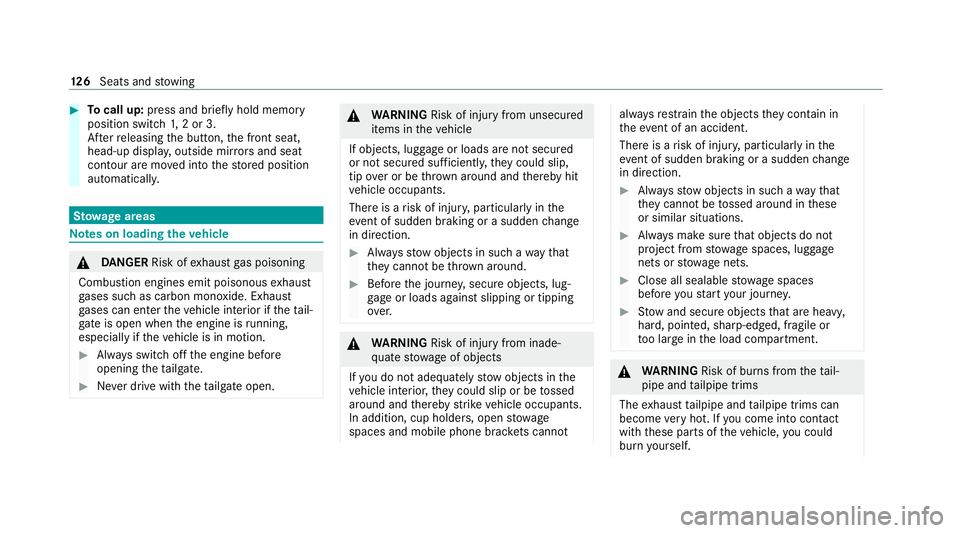
#
Tocall up: press and brief lyhold memory
position switch 1,2 or 3.
Af terre leasing the button, the front seat,
head-up displa y,outside mir rors and seat
con tour are mo ved into thestored position
automaticall y. St
ow age areas Note
s on loading theve hicle &
DANG ER Risk of exhaust gas poisoning
Combustion engines emit poisonous exhaust
ga ses such as carbon monoxide. Exhaust
ga ses can enter theve hicle interior if theta il‐
gate is open when the engine is running,
especially if theve hicle is in motion. #
Alw ays switch off the engine before
opening theta ilgate. #
Never drive with theta ilgate open. &
WARNING Risk of inju ryfrom unsecu red
items in theve hicle
If objects, luggage or loads are not secured
or not secured suf ficientl y,they could slip,
tip ove r or be throw n around and thereby hit
ve hicle occupants.
There is a risk of injur y,particularly in the
ev ent of sudden braking or a sudden change
in direction. #
Alw aysstow objects in such a wayth at
th ey cannot be thro wn around. #
Before the journe y,secure objects, lug‐
ga ge or loads against slipping or tipping
ove r. &
WARNING Risk of inju ryfrom inade‐
qu ate stow age of objects
If yo u do not adequately stowobjects in the
ve hicle interior, they could slip or be tossed
around and thereby strike vehicle occupants.
In addition, cup holders, open stowage
spaces and mobile phone brac kets cann ot alw
aysre stra in the objects they contain in
th eev ent of an accident.
There is a risk of injur y,particularly in the
ev ent of sudden braking or a sudden change
in direction. #
Alw aysstow objects in such a wayth at
th ey cannot be tossed around in these
or similar situations. #
Alw ays make sure that objects do not
project from stowage spaces, luggage
nets or stowage nets. #
Close all sealable stowage spaces
before youstart your journe y. #
Stow and secure objects that are heavy,
hard, poin ted, sharp-edged, fragile or
to o lar geinthe load compartment. &
WARNING Risk of bu rns from theta il‐
pipe and tailpipe trims
The exhaust tailpipe and tailpipe trims can
become very hot. If you come into contact
with these parts of theve hicle, you could
burn yourself. 12 6
Seats and stowing
Page 130 of 689
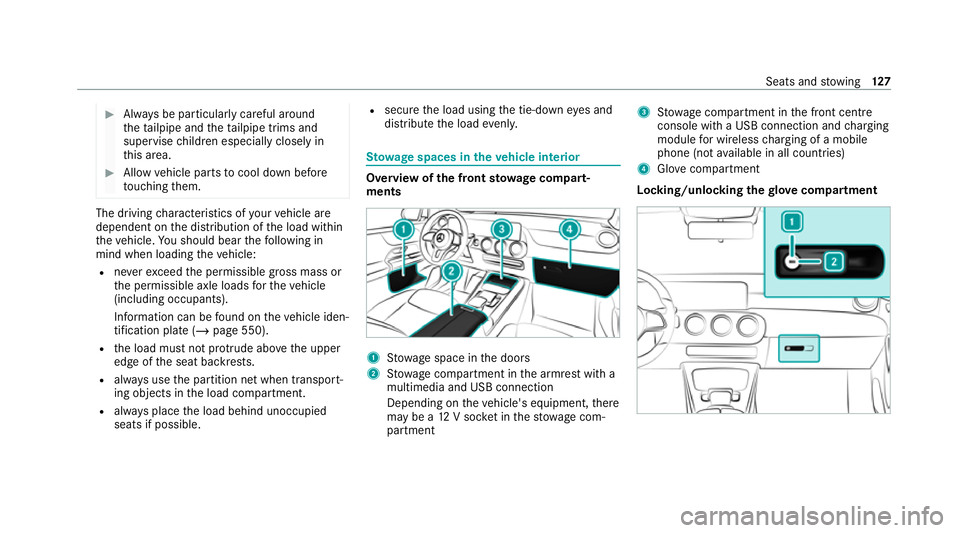
#
Alw ays be particular lycareful around
th eta ilpipe and theta ilpipe trims and
supervise children especially closely in
th is area. #
Allow vehicle parts tocool down before
to uching them. The driving
characteristics of your vehicle are
dependent on the distribution of the load within
th eve hicle. You should bear thefo llowing in
mind when loading theve hicle:
R neverex ceed the permissible gross mass or
th e permissible axle loads forth eve hicle
(including occupants).
Information can be found on theve hicle iden‐
tification plate (/ page 550).
R the load must not pr otru de abo vethe upper
edge of the seat backrests.
R always use the partition net when transport‐
ing objects in the load compartment.
R always place the load behind unoccupied
seats if possible. R
secure the load using the tie-down eyes and
distribute the load evenl y. St
ow age spaces in theve hicle interior Overview of
the front stowage compa rt‐
ments 1
Stow age space in the doors
2 Stow age compartment in the armrest with a
multimedia and USB connection
Depending on theve hicle's equipment, there
may be a 12V soc ket in thestow age com‐
partment 3
Stow age compartment in the front cent re
console wi tha USB connection and charging
module for wireless charging of a mobile
phone (not available in all countries)
4 Glovecompa rtment
Locking/unlo cking thegl ove compa rtment Seats and
stowing 127
Page 500 of 689
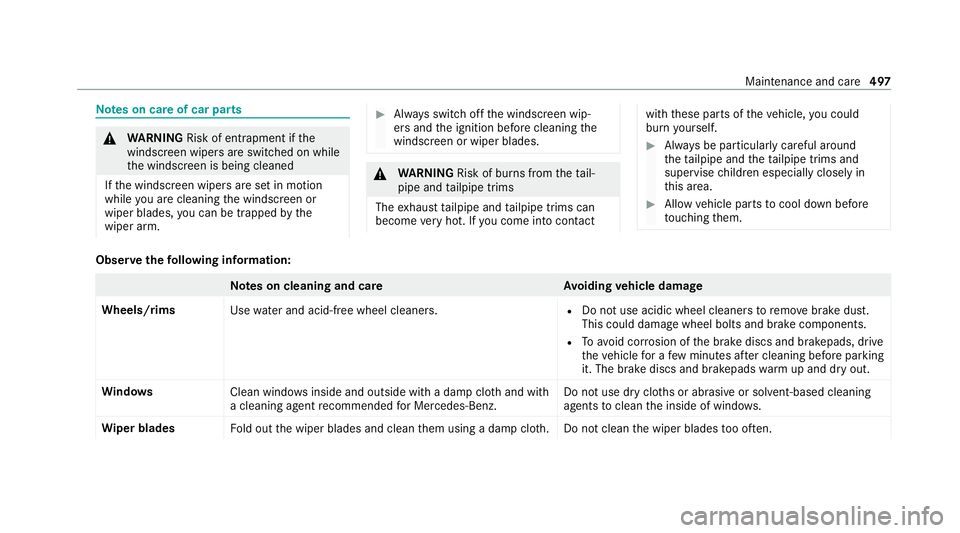
Note
s on care of car parts &
WARNING Risk of entrapment if the
windscreen wipers are swit ched on while
th e windscreen is being cleaned
If th e windscreen wipers are set in motion
while you are cleaning the windscreen or
wiper blades, you can be trapped bythe
wiper arm. #
Alw ays switch off the windscreen wip‐
ers and the ignition before cleaning the
windscreen or wiper blades. &
WARNING Risk of bu rns from theta il‐
pipe and tailpipe trims
The exhaust tailpipe and tailpipe trims can
become very hot. If you come into contact with
these parts of theve hicle, you could
burn yourself. #
Alw ays be particular lycareful around
th eta ilpipe and theta ilpipe trims and
supervise children especially closely in
th is area. #
Allow vehicle parts tocool down before
to uching them. Obser
vethefo llowing information: Note
s on cleaning and car eA voiding vehicle damage
Wheels/rims Usewate r and acid-free wheel cleaners. R
Do not use acidic wheel cleaners toremo vebrake dust.
This could damage wheel bolts and brake components.
R Toavoid cor rosion of the brake discs and brakepads, drive
th eve hicle for a few minutes af ter cleaning before parking
it. The brake discs and brakepads warm up and dry out.
Wi ndo ws
Clean windowsinside and outside with a damp clo thand with
a cleaning agent recommended for Mercedes-Benz. Do not use dry clo
ths or abrasive or sol vent-based cleaning
agents toclean the inside of windo ws.
Wi per blades
Fold out the wiper blades and clean them using a damp clo th.D o not clean the wiper blades too of ten. Maintenance and care
497
Page 507 of 689
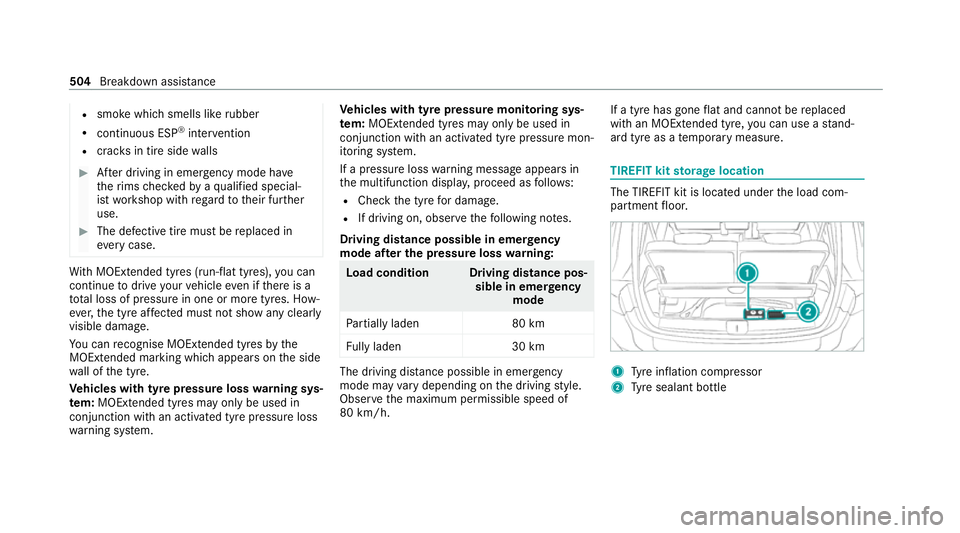
R
smoke which smells like rubber
R continuous ESP ®
inter vention
R crac ksin tire side walls #
After driving in emergency mode ha ve
th erims checkedby aqu alified special‐
ist workshop with rega rd totheir fur ther
use. #
The defective tire must be replaced in
eve rycase. Wi
th MOExtended tyres (run-flat tyres), you can
continue todrive your vehicle even if there is a
tot al loss of pressure in one or more tyres. How‐
eve r,th e tyre af fected must not show any clearly
visible damage.
Yo u can recognise MOExtended tyres bythe
MOExtended marking which appears on the side
wa ll of the tyre.
Ve hicles with tyre pressure loss warning sys‐
te m: MOExtended tyres may only be used in
conjunction wi than activated tyre pressure loss
wa rning sy stem. Ve
hicles with tyre pressure monitoring sys‐
te m: MOExtended tyres may only be used in
conjunction wi than activated tyre pressure mon‐
itoring sy stem.
If a pressure loss warning message appears in
th e multifunction displa y,proceed as follo ws:
R Check the tyre for dama ge.
R If driving on, obser vethefo llowing no tes.
Driving distance possible in emer gency
mode af ter the pressure loss warning: Load condition Driving distance pos‐
sible in emergency
mode
Pa rtially laden 80 km
Fu lly laden 30 km The driving dis
tance possible in emergency
mode may vary depending on the driving style.
Obser vethe maximum permissible speed of
80 km/h. If a tyre has gone
flat and cannot be replaced
with an MOEx tended tyre, you can use a stand‐
ard tyre as a temp orary measure. TIREFIT kit
storage location The TIREFIT kit is located under
the load com‐
partment floor. 1
Tyre inflation compressor
2 Tyre sealant bottle 504
Breakdown assis tance
Page 528 of 689

Note
s on snow chains &
WARNING Risk of accident due toincor‐
re ct snow chain fitting
If yo ufit snow chains tothere ar wheels, the
snow chains may grind against theve hicle
body or chassis components.
This could cause damage totheve hicle or
th e tyres. #
Neverfit snow chains tothere ar
wheels. #
Alw aysfit snow chains tothe front
wheels in pairs. *
NO
TEDama getocomponents of the
ve hicle body or chassis due tofitted
snow chains If
yo ufit snow chains tothe front wheels of
4MATIC vehicles, you may damage co mpo‐
nents of theve hicle body or chassis. #
Onlyfit snow chains tothere ar wheels
of 4MATIC vehicles. *
NO
TEDama getothe wheel trim from fit‐
te d snow chains If sn
ow ch ains are fitted tosteel wheels, the
wheel trims can be damaged. #
Remo vethe wheel trims of steel wheels
before fitting snow chains. Obse
rveth efo llowing no tes when using snow
ch ains:
R Snow ch ains are on ly permissible for cer tain
wheel/tyre combinations. You can obtain
information about this from a Mercedes-Benz
Service Cent re.
R For saf etyre asons, on lyuse sn ow chainsthat
ha ve been specifically appr ovedfo ryo ur
ve hicle byMercedes-Benz, or snow chains
with the same quality standard.
R If sn ow ch ains are fitted, the maximum per‐
missible speed is 50 km/h.
R Vehicles with Active Park ing Assis t:do
not use Active Parking Assist when snow
ch ains are fitted. %
You can permanently limit the maximum
ve hicle speed for driving with winter tyres
(/ page 241).
% You can deactivate ESP ®
to pull away
( / page 230). This allo wsthe wheels to
spin, achieving an increased driving forc e. Ty
re pressure Note
s on tyre pressure &
WARNING Risk of accident due toinsuf‐
fi cient or excessive tyre pressure
Underinfla ted or overinfla ted tyres pose the
fo llowing risks:
R The tyres may bur st, especially as the
load and vehicle speed increase.
R The tyres may wearexc essively and/or
une venly, which may greatlyimpair tyre
traction.
R The driving characteristics, as well as
st eering and braking, may be greatly
impaired. Wheels and tyres
525
Page 648 of 689
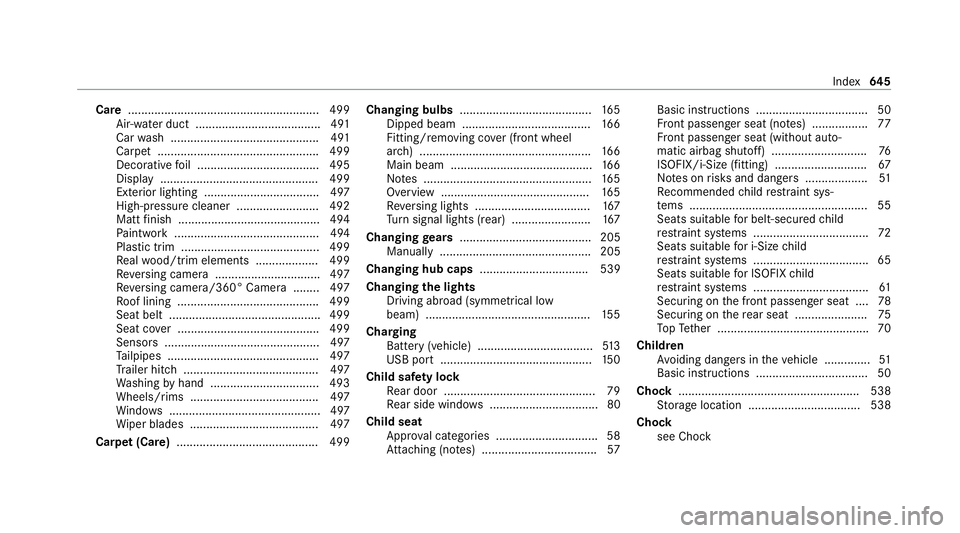
Care
.......................................................... 499
Air-water duct ...................................... 491
Car wash ............................................. 491
Carpet .................................................4 99
Decorative foil .................................... .495
Displ ay................................................ 499
Exterior lighting ................................... 497
High-pressure cleaner ......................... 492
Matt finish ........................................... 494
Pa int wo rk ............................................ 494
Plastic trim .......................................... 499
Re alwo od/trim elements ...................4 99
Re versing camera ................................ 497
Re versing camera/360° Camera ........ 497
Ro of lining ...........................................4 99
Seat belt .............................................. 499
Seat co ver ........................................... 499
Sensors ............................................... 497
Ta ilpipes .............................................. 497
Tr ailer hit ch......................................... 497
Wa shing byhand ................................. 493
Wheels/rims ....................................... 497
Wi ndo ws .............................................. 497
Wi per blades .......................................4 97
Carpet (Care) .......................................... .499 Changing bulbs
........................................ 16 5
Dipped beam ....................................... 16 6
Fitting/removing co ver (front wheel
ar ch ) .................................................... 16 6
Main beam ...........................................1 66
No tes ................................................... 16 5
Overview ............................................. 16 5
Re versing lights .................................. .167
Tu rn signal lights (rear) ........................ 167
Changing gears ........................................ 205
Manually .............................................. 205
Changing hub caps ................................. 539
Changing the lights Driving ab road (symm etrical low
beam) .................................................. 15 5
Cha rging
Bat tery (vehicle) ...................................5 13
USB port ..............................................1 50
Child saf ety lock
Re ar door .............................................. 79
Re ar side wind ows................................. 80
Child seat Appr oval categories .............................. .58
At tach ing (no tes) ................................... 57Basic instructions .................................. 50
Fr
ont passenger seat (no tes) ................. 77
Fr ont passenger seat (without auto‐
matic airbag shutoff) ............................. 76
ISOFIX/i-Size (fitting) ............................ 67
No tes on risks and dangers ...................51
Re commended child restra int sys‐
te ms ...................................................... 55
Seats suita blefor belt-secu redch ild
re stra int sy stems ................................... 72
Seats suitable for i‑Size child
re stra int sy stems ................................... 65
Seats suitable for ISOFIX child
re stra int sy stems ................................... 61
Secu ring on the front passenger seat ....78
Secu ring on there ar seat ...................... 75
To pTe ther ..............................................70
Child ren
Av oiding dangers in theve hicle .............. 51
Basic instructions .................................. 50
Cho ck....................................................... 538
St orage location ..................................5 38
Cho ck
see Chock Index
645
Page 673 of 689
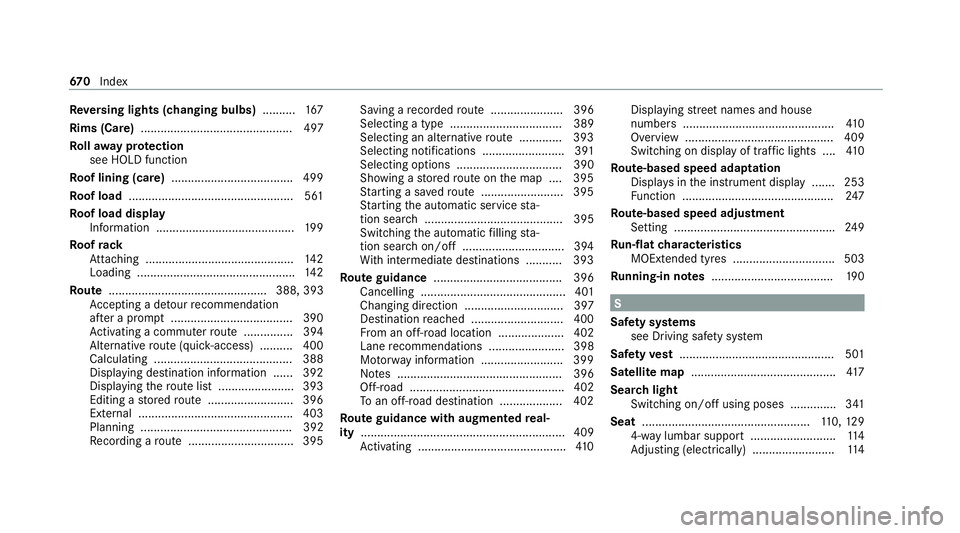
Re
versing lights (changing bulbs) ..........167
Rims (Care) .............................................. 497
Ro llaw ay protection
see HOLD function
Ro of lining (care) .................................... .499
Ro of load .................................................. 561
Ro of load display
In fo rm ation .......................................... 19 9
Ro ofrack
At tach ing ............................................ .142
Loading ................................................ 14 2
Ro ute ................................................ 388, 393
Ac cepting a de tour recommendation
af te r a prom pt..................................... 390
Ac tivating a commuter route .............. .394
Alternati veroute (quic k-access) .......... 400
Calculating .......................................... 388
Displaying destination information ...... 392
Displaying thero ute list ...................... .393
Editing a stored route .......................... 396
Ex tern al .............................................. .403
Planning .............................................. 392
Re cording a route ................................ 395 Saving a
recorded route ...................... 396
Selecting a type .................................. 389
Selecting an alternative route ............ .393
Selecting notifications ......................... 391
Selecting options ................................ 390
Showing a stored route on the map ....3 95
St arting a sa vedro ute ........................ .395
St arting the automatic service sta‐
tion sear ch.......................................... 395
Switching the automatic filling sta‐
tion sear chon/off ...............................3 94
Wi th intermediate destinations .......... .393
Ro ute guidance ....................................... 396
Cancelling ............................................ 401
Changing direction .............................. 397
Destination reached ............................ 400
Fr om an off-road location .................... 402
Lane recommendations ....................... 398
Mo torw ay information ........................ .399
No tes .................................................. 396
Off-road ............................................... 402
To an off- road destination .................. .402
Ro ute guidance with augmented real‐
ity .............................................................. 409
Ac tivating ............................................ .410 Displ
aying stre et names and house
numbe rs.............................................. 41 0
Overview ............................................. 409
Switching on display of traf fic lights .... 41 0
Ro ute-based speed adaptation
Displ ays in the instrument display .......2 53
Fu nction .............................................. 247
Ro ute-based speed adjustment
Setting ................................................ .249
Ru n-flat characteristics
MOExtended tyres ............................... 503
Ru nning-in no tes .....................................1 90 S
Saf ety sy stems
see Driving saf ety sy stem
Saf etyve st ............................................... 501
Satelli temap ............................................ 417
Sear chlight
Swit ching on/off using poses .............. 341
Seat .................................................. .110,12 9
4-w aylumbar support .......................... 11 4
Ad justing (electrically) ........................ .114 67 0
Index